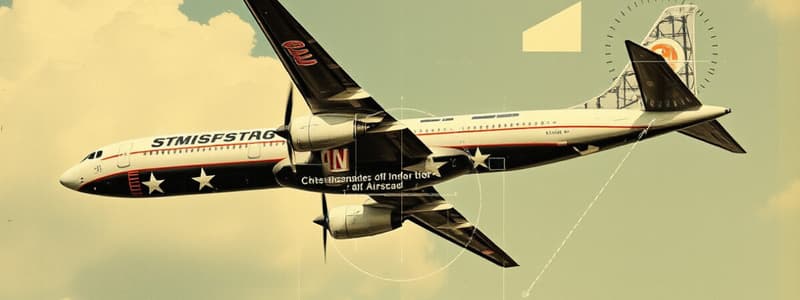Podcast
Questions and Answers
What is the acronym for Class E airspace types?
What is the acronym for Class E airspace types?
- CLASS
- SETFODA (correct)
- NONE
- AIRSPACE
What does 'S' stand for in Class E airspace types?
What does 'S' stand for in Class E airspace types?
Surface
What does 'E' stand for in Class E airspace types?
What does 'E' stand for in Class E airspace types?
Extension
What does 'T' represent in Class E airspace types?
What does 'T' represent in Class E airspace types?
What does 'F' signify in Class E airspace types?
What does 'F' signify in Class E airspace types?
What does 'O' stand for in Class E airspace types?
What does 'O' stand for in Class E airspace types?
What does 'D' represent in Class E airspace types?
What does 'D' represent in Class E airspace types?
What does 'A' signify in Class E airspace types?
What does 'A' signify in Class E airspace types?
If the previous 7 types of Class E airspace were not depicted on a sectional chart, where would Class E airspace begin?
If the previous 7 types of Class E airspace were not depicted on a sectional chart, where would Class E airspace begin?
Flashcards are hidden until you start studying
Study Notes
Class E Airspace Types
- Class E airspace can be remembered using the acronym SETFODA.
Surface
- Class E airspace at the surface includes specific operations near airports and is designated for enhanced safety.
Extension
- This type refers to extensions around some airports that allow for air traffic maneuvering outside the confines of Class B or Class C airspace.
Transition
- Transition areas exist between 700 feet Above Ground Level (AGL) and 1200 feet AGL, allowing aircraft to transition to and from the terminal airspace.
Federal Airways
- Known as Victor airways, Jet routes, and include NDB routes, Atlantic, Gulf, and Bahamian routes. Used primarily by IFR (Instrument Flight Rules) aircraft.
Off-Shore
- This type includes airspace over the ocean, which is essential for managing traffic in maritime environments.
Domestic En-route
- This is the airspace utilized by aircraft traveling among domestic routes, effective for maintaining organized traffic flow over land.
Above FL600
- Refers to airspace that starts above Flight Level 600 (FL600), used for high-altitude operations and specific air traffic management needs.
Undepicted Class E Airspace
- If the seven types of Class E airspace mentioned are not shown on a sectional chart, Class E airspace begins at 14,500 feet Mean Sea Level (MSL).
Studying That Suits You
Use AI to generate personalized quizzes and flashcards to suit your learning preferences.




